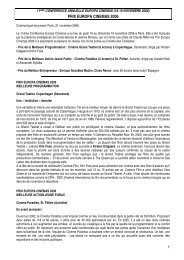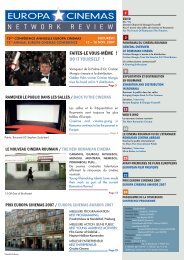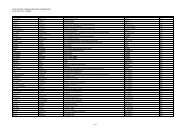Supplément du Film français - Europa Cinemas
Supplément du Film français - Europa Cinemas
Supplément du Film français - Europa Cinemas
You also want an ePaper? Increase the reach of your titles
YUMPU automatically turns print PDFs into web optimized ePapers that Google loves.
18 Numérique / Digital19Les exploitants europEenscontinuent d’avancernumEriquementLe passage au numérique a donné beaucoup de travail auxexploitants <strong>du</strong> monde entier. En Europe, la tâche est d’autantplus complexe que le parc est hétérogène et les normes DCI,adoptée par Bruxelles, font achopper certains. n Liza ForemanSelon l’Unic, la Norvègea été le premier payseuropéen à avoir numérisétotalement son parc.According to UNIC,Norway was the firstEuropean country to reachcomplete digitization.D ’aprèsles derniers chiffres de Média Salles,une organisation <strong>du</strong> programme MEDIAqui assure la promotion <strong>du</strong> cinéma européen,le continent comptait 21 789 écransnumériques au 30 juin, alors qu’il n’y enavait que 1 535 en 2009. Il s’agit d’un progrèsconsidérable. Selon l’étude, la France dispose <strong>du</strong> plusgrand nombre d’écrans numériques en Europe (4 397). Elleest suivie <strong>du</strong> Royaume-Uni (3 216), de l’Allemagne (2 500), del’Italie (1 815) et de l’Espagne, (1 750). Même l’Andorre peut setarguer d’en avoir trois !Au cours de l’année 2011, 54% des écrans européens ont éténumérisés, selon l’Union internationale des cinémas (Unic).Il s’agit de tenir le rythme dans le cadre de la numérisationdes salles <strong>du</strong> monde entier. Le nombre d’écrans numériquesen Europe a augmenté de 79% entre le 1 er janvier 2011 et le 1 erjanvier 2012. Ad Weststrate, président de l’Unic, commentaitdans le rapport annuel de l’organisation, en 2011 : “Cela nes’est pas fait en fanfare, mais le moment où le nombre d’écransnumériques dans le monde a dépassé les 50%, en janvier 2012,© DRmarque indéniablement un tournant pour tous les acteurs <strong>du</strong>secteur. C’est à la fois une formidable nouvelle et une piqûrede rappel pour tous ceux qui n’ont pas encore pris leurs dispositions,car le temps presse. Une fois dépassées les difficultésfinancières et logistiques, l’héritage culturel, économique etsocial de la numérisation sera essentiel dans notre in<strong>du</strong>striependant des années.” D’après l’Unic, la Norvège a été le premierpays européen à avoir numérisé totalement son parc, suivipar le Luxembourg en 2011.Parallèlement, selon Média Salles, le taux de pénétration <strong>du</strong> numériquedans les cinémas, en juin de cette année, s’établissaità 93% en Belgique, 60% en Andorre, 52% en Irlande, 29% enLettonie, 25% en Lituanie et 16% à Malte, pour ne donner quequelques exemples. Certains exploitants européens ont exigéune norme moins élevée, en espérant que cela aiderait les pluspetits cinémas à effectuer cette transition. Mais l’Unic a annoncéqu’elle continuait de soutenir la norme DCI, acceptée dans lemonde entier, ce qui montre l’importance des exploitants européenssur le marché mondial. “L’annonce de la commercialisationde projecteurs à moindre coût, qui respecteront la normeDCI faite par plusieurs fabricants, en avril, est la preuve que[celle-ci] demeure la norme consacrée pour tous les cinémas ”,a déclaré l’organisation. “Il est trop tôt pour prédire l’impact <strong>du</strong>tournant numérique, a confié Jan Runge, Pdg de l’Unic. En cequi concerne les problèmes des petits opérateurs et des pays oùil n’existe aucun soutien, il s’agit d’un autre volet.” Les pays lesplus en avance sont la France, le Royaume-Uni, la Scandinavie,les Pays-Bas et le Luxembourg. Selon Runge, l’Espagne, l’Italieet la Grèce ont toujours beaucoup de retard à rattraper. 80%des salles européennes devraient être passées au numériqued’ici à la fin de l’année.Inquiétude sur la fin <strong>du</strong> 35 mmLes exploitants d’art et essai en Europe ont exprimé leurs préoccupationspar rapport aux défis que pose, pour leur secteur,la fin <strong>du</strong> 35 mm. Ils craignent qu’il ne soit très difficile de se procurerdes copies. “Les distributeurs indépendants vont cesser lalivraison en 35 mm car les laboratoires n’auront bientôt plus lesmoyens de travailler efficacement”, a déclaré le président de laCicae, Detlef Rossmann, lors d’une récente convention.L’Unic, la Cicae et <strong>Europa</strong> <strong>Cinemas</strong> incitent les décideurseuropéens à mettre le cinéma au cœur d’un “nouvel agenda”.En Septembre, l’Unic, la Cicae et <strong>Europa</strong> <strong>Cinemas</strong> ont inscritla transition numérique au coeur de leurs préoccupationsen envoyant une lettre ouverte à Bruxelles. “Les exploitantsdans toute l’Europe vivent actuellement une phase critiqueet passionnante avec le passage à la technologie numérique.Cependant, de nombreux établissements de petite et moyennetailles ont toujours beaucoup de mal à financer cette transition.C’est aujourd’hui la question la plus pressante pour l’in<strong>du</strong>strieeuropéenne <strong>du</strong> film. Si elle n’est pas traitée, elle entraveral’accès au cinéma dans de nombreuses régions d’Europe.”Message reçu à Bruxelles qui s’apprête à lancer un 3 e voletd’aide à l’équipement numérique. ❖© DREuropean cinemaexhibitors continueto reach digitalmilestonesMaking the transition to digital is a mammothundertaking for cinema exhibitors worldwide. InEurope, the task is even more complex as the parkis heterogeneous and Brussels’ DCI standardsremain a stumbling block for some operators.n Liza ForemanAccording to the most recent figures from Média Salles, aninitiative of the European Union Media programme to promoteEuropean cinema, Europe had 21,789 digital screens as of 30June, compared to only 1,535 in 2009, a remarkable progress.As per the study, France currently has the most digital screensin Europe (4,397), followed by the United Kingdom (3,216),Germany (2,500), Italy (1,815), and Spain (1,750). EvenAndorra boasts three!Through 2011, 54% of European screens had been digitized,according to the International Union of <strong>Cinemas</strong> (UNIC). Thisis in keeping with the worldwide roll-out of digital in theatres.Their number grew by 79% from 1 January 2011 to 1 January2012. Ad Weststrate, president of the trade organization, commentedin its 2011 report on cinema: “Although it happenedwith little fanfare, the moment at which digital screens becamea majority worldwide – we passed 50% in January 2012 –undoubtedly represented a tipping point for the in<strong>du</strong>stry. Thisis both exciting news and a reminder to those who have notyet taken action that time to do so is running out. Once weovercome the financial and logistical difficulties of the roll-out,the cultural, social and economic legacy of digitization willremain a key aspect of our sector for years to come.” Accordingto UNIC, Norway was the first European country to reach completedigitization, followed by Luxembourg in 2011.Média Salles, meanwhile, states that the projected penetrationrate of digital cinemas, through June 2012, ranged from 93%in Belgium to 60% in Andorra, 52% in Ireland, 29% in Latvia,25% in Lithuania and 16% in Malta, to give a few examples.Some operators in Europe have demanded a lower standardfor digital cinema in the belief that this could potentially helpsmaller theatres cope with the conversion. But UNIC has saidthat it continues to support the globally-accepted DCI stan-dard, which reflects the important place of European exhibitorsin the worldwide market. “The announcement of lower-costbut still DCI-compliant projectors from various manufacturerslast April underlines the fact that the DCI standard remainsthe appropriate standard for all cinemas,” the organizationsaid. “It’s too early to call the kind of impact the digital shiftwill have,” Jan Runge, CEO of UNIC, said. “With regards tothe problems for smaller operators and countries where nosupport exists, this is another matter.” The most advancedcountries are France, the U.K., Scandinavia, the Netherlandsand Luxembourg. Spain, Italy and Greece still have some catchingup to do, Runge adds. 80% of European screens areexpected to be digitized by the end of this year.Concern regarding 35mm switch-offEuropean art house exhibitors have expressed concern aboutthe challenges posed for their sector by the 35mm switch-off.The fear is that it will become difficult to get 35mm prints inmany of these countries. “The independent distributors willcease 35mm print delivery. The fact is that the labs will closedown – one has already done so in Germany – and there willalso be delivery-related problems in the smaller countries becauselabs will no longer be able to work efficiently,” CICAEpresident Detlef Rossmann said at a recent convention.UNIC, CICAE and <strong>Europa</strong> <strong>Cinemas</strong> have urged policy-makersin Brussels to put cinema at the centre of a “new agendafor film.” In September, UNIC, CICAE and <strong>Europa</strong> <strong>Cinemas</strong>scored the digital transition at the heart of their concerns bysending an open-letter to Brussels. “The operators accross<strong>Europa</strong> are experiencing an exciting and critical phase withthe transition to digital. However, some small and mediumsizedcinemas still struggle to finance this important transitionand are at present in danger of closure if no financing solutionsare found. This is the most pressing issue for Europe’s filmin<strong>du</strong>stry to date and, if not solved, could devastate accessto local cinemas across some important regions of Europe.”Message received in Brussels with the launch, by the end of theyear, of a third plan to support digital equipment. ❖Le projecteur <strong>du</strong> DCA,à Dundee.The movie projector,at Dundee’s DCA.<strong>Europa</strong> <strong>Cinemas</strong> 20 e anniversaire<strong>Europa</strong> <strong>Cinemas</strong> 20 th anniversary
















